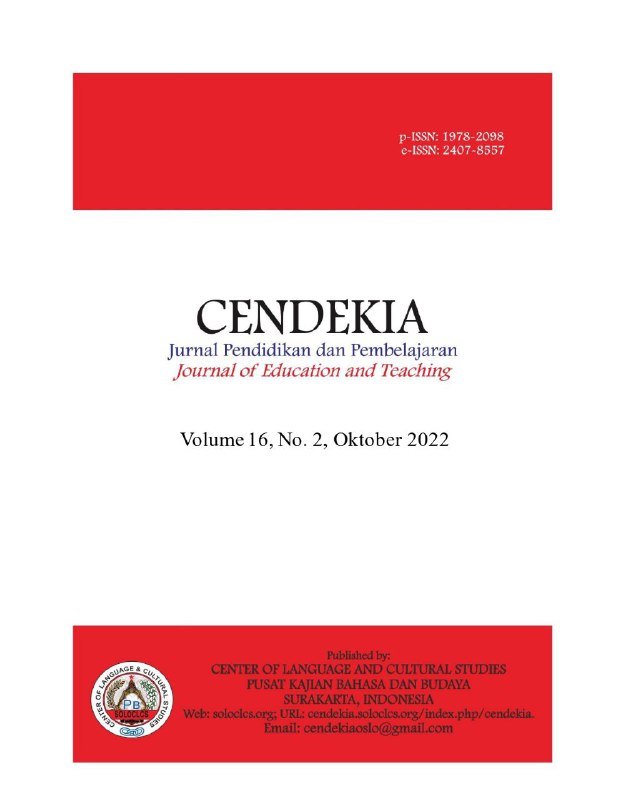RETELLING STORIES THROUGH PICTURE SERIES TO IMPROVE STUDENTS SPEAKING SKILL
DOI:
https://doi.org/10.30957/cendekia.v16i2.732Keywords:
story-telling, picture, speakingAbstract
Speaking is an effective language talent in verbal exchange that is incorporated collectively with the opposite language competencies consisting of listening, writing, and analyzing despite the grammatical, pronunciation, and vocabulary. This article aims to explain the concept of speaking skills, the implementation of picture series to retelling stories for speaking skills, and the advantages and disadvantages of the retelling story technique. The method of collecting data is through library research and documentation. The data were collected from books and manuscripts. The analysis of data used qualitative data analysis using Miles and Huberman's data analysis process by organizing the information, description, and interpretation. The results of this study show that retelling stories are useful for improving students' ability to speak English by using pictures to improve students' speaking skills.
Downloads
References
REFERENCES
Afriani, C., Apriliaswati, R., & Husin, S. (2018). Retelling Recount Stories by Using Picture Series in Improving Students’ Speaking Skill. Jurnal Pendidikan dan Pembelajaran Khatulistiwa, 7(7).
Anriani, I. (2020). Retelling Story through Picture Series to Improve Students Speaking Skill at the 8th Grade Students of SMPN 3 Ranteangin (Pre-Experimental Research).
Arbain, M., Ramadani, F., & Novika, H. (2018). Teaching Speaking Skill Using Picture Series: Ways, Obstacles And Attempts To Solve. Intensive Journal, 1(1), 30-42.
Arung, F., & Jumardin, J. (2016). Improving the students’ speaking skills through debate techniques. Journal of English Education, 1(1), 70-76.
Arung, F., & Jumardin, J. (2016). Improving the students’ speaking skills through debate techniques. Journal of English Education, 1(1), 70-76.
Egan, K. B. (1999). Speaking: A critical skill and a challenge. Calico Journal, 277-293.
Hastari, T. (2019, June). Improving Students’ Speaking Skill and Self Confident Using Retelling of Fifth Grade Students. In 3rd International Conference on Current Issues in Education (ICCIE 2018) (pp. 489-496). Atlantis Press.
Khoiruddin, M. (2014). The Effectiveness of Using Series of Pictures as Media to Improve the Students Speaking Ability at Storytelling: A Case Study of SMA Negeri 2 Purwodadi. ETERNAL (English Teaching Journal), 5(1).
Mailani, P. N. A., & Farhana, R. (2018). Teaching Speaking Through Picture Series. PROJECT (Professional Journal of English Education), 1(5), 645-650.
Nurhayati, D. A. W. (2014). Using Picture Series to Inspire Reading Comprehension for the Second Semester Students of English Department of IAIN Tulungagung. Dinamika Ilmu, 14(2), 176-189.
Nuryadi. (2017). “Using Picture Series in Teaching Procedure Text to Improve the Students Speaking Ability at Grade Eight of SMP Negeri 2 Deket in the Academic Year 2013/2014â€.
Praneetponkrang, S., & Phaiboonnugulkij, M. (2014). The Use of Retelling Stories Technique in Developing English Speaking Ability of Grade 9 Students. Advances in Language and Literary Studies, 5(5), 141-154.
Purwatiningsih, P. (2015). Improving speaking ability through storytelling technique by using picture series. Journal on English as a Foreign Language, 5(1), 57-66.
Rostam, N. A. (2019). Using Storytelling with picture series to improve students speaking skills.
Sembiring, N., & Ginting, F. Y. (2019). Improving students’ speaking achievement by using storytelling techniques. Budapest International Research and Critics in Linguistics and Education (BirLE) Journal, 2(4), 179-184.
Zainatuddar, Z. (2015). Teaching Speaking in English by Using the Picture Series Technique. English Education Journal, 6(4), 443-456.
Downloads
Published
How to Cite
Issue
Section
License
Authors who publish with this journal agree to the following terms:
- Authors retain copyright and grant the journal right of first publication with the work simultaneously licensed under a Creative Commons Attribution-ShareAlike 4.0 International License that allows others to share the work with an acknowledgement of the work's authorship and initial publication in this journal.
- Authors are able to enter into separate, additional contractual arrangements for the non-exclusive distribution of the journal's published version of the work (e.g., post it to an institutional repository or publish it in a book), with an acknowledgement of its initial publication in this journal.
- Authors are permitted and encouraged to post their work online (e.g., in institutional repositories or on their website) prior to and during the submission process, as it can lead to productive exchanges, as well as earlier and greater citation of published work (See The Effect of Open Access).












